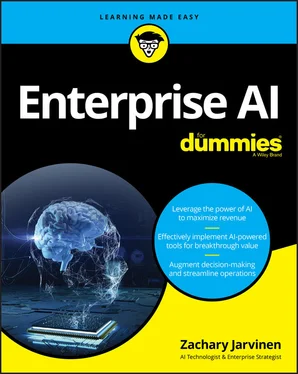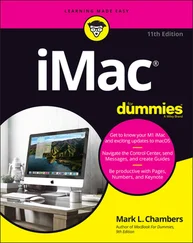To extend the experience beyond what’s in print here today, I’ve put together these additional resources:
Cheat sheet: A quick reference to the major bullets and tables from the book. Feel free to print and post to your wall or simply glance at it when you need a reminder of some of the most fundamental concepts of Enterprise AI. You can find the cheat sheet by going to www.dummies.com and searching for Enterprise AI For Dummies Cheat Sheet .
Updates: I've written this book to expose essential groundwork and use cases that will remain evergreen. That said, as this topic will likely only receive more prominence, not less, over the years to come, I also plan to publish updates, as applicable. They will be available on www.dummies.com as well by searching for Enterprise AI For Dummies. Additionally, input about this content is welcome directly through my site, www.zachonomics.com , where book-related talks and articles are also posted.
There’s no harm in starting at Chapter 1and reading right through, but unless you want to learn how AI can be used in a wide array of vertical markets and horizontal applications, you will likely want to dip into the areas of most interest to you and save the rest for another time.
Maybe you’ve noticed AI in the news, glanced at the headlines, skimmed a few articles, watched a video or two, but you’re still not completely certain that you know how it works and how you can use it. If so, before diving into the practical applications, start with Chapter 1, which provides some background about why companies are turning to AI to solve their problems and takes you on a tour of the four pillars on which modern AI is built.
You might have heard the term algorithm tossed about casually and wondered what one looks like. In that case, the last third of Chapter 1is for you. It covers all the cool ideas, such as machine learning, deep learning, and text mining, to mention a few, not at a deep technical level, but at the level required to understand how you can use them to address your business challenges.
If you are looking for real-life examples of how AI has been used in the past and how it is being used now to solve business problems, read Chapter 2.
If you want to explore what it takes to get an AI project up and running in your business, check out Chapter 3.
If you’d like to take a deeper look at how you can use AI in your market, flip to Part 2. For each market, the chapters cover these areas:
The challenges facing that market
How AI can save costs, increase revenue, and support new business models
A look under the hood to see the AI techniques that make it happen
Specific use cases that allow you to leverage AI to grow your organization
Part 3looks forward to future applications of AI, as well as sets out a framework of guardrails, so instead of approaching the topic like a panacea, you are equipped with a grounding that will set you and your organization up for a successful implementation.
Part 4looks at ways AI will affect the coming decades and why AI is not the final answer for all your business issues.
Part 1
Exploring Practical AI and How It Works
IN THIS PART …
Discover how you can use AI in your organization.
Look under the hood to see how AI works.
Learn the difference between pure AI and practical AI.
Explore common use cases for AI.
Discover best practices for designing an AI project.
Chapter 1
Demystifying Artificial Intelligence
IN THIS CHAPTER
 Discovering how you can use AI
Discovering how you can use AI
 Recognizing the key technologies that make AI possible
Recognizing the key technologies that make AI possible
 Looking under the hood to see how it works
Looking under the hood to see how it works
While some have traced the history of artificial intelligence back to Greek mythology and philosophers, fast-forward with me to the twentieth century when serious work on AI was directed to practical applications.
The term artificial intelligence was first used in a 1955 proposal for the Dartmouth Summer Research Project on Artificial Intelligence, in which American computer scientist John McCarthy and others wrote:
“We propose that a 2-month, 10-man study of artificial intelligence be carried out during the summer of 1956 at Dartmouth College in Hanover, New Hampshire. The study is to proceed on the basis of the conjecture that every aspect of learning or any other feature of intelligence can in principle be so precisely described that a machine can be made to simulate it.”
Over the following decades, AI progress waxed and waned as development overcame one obstacle only to encounter another.
In this chapter, you get an idea of what, why, and how:
What the fuss is all about, what AI can do for you, and what it can’t.
Why now and not 20 years ago, and why AI is suddenly all the rage and wherever you look you see news about everything from self-driving cars to AI-powered showerheads.
How it works, and how all the moving parts fit together to solve interesting and challenging problems.
Before I go any further, let me get a few definitions out of the way right up front so you’ll know what I mean when I use a term.
Algorithm:A set of rules and calculations used for problem-solving. Some compare an algorithm to the process you follow when you make dinner. The problem to be solved is getting a fully prepared meal on the table, and the algorithm consists of the recipes you use to turn ingredients into the dishes you will serve. An algorithm is not a magic formula; it’s just a regular kind of formula, or rather a set of formulas and instructions.
Machine learning:A collection of algorithms that discover relationships in data with an associated level of confidence based on the likelihood, or probability, that it is a true relationship. Note that I didn’t say ML teaches the machine to think or make decisions the same way humans do. It’s just math. Some pretty fancy math, but still math.
Artificial intelligence:A collection of machine-learning and related technologies used to accomplish tasks that normally require human intelligence, such as to recognize and categorize speech, identify an object or person in a photo or video, or summarize the content of a social media post.
It comes down to pattern recognition. You can think of the human brain as a massively parallel pattern-recognition engine. AI enlists the processing power of computers to automate pattern recognition.
In some ways, AI is more powerful than the human brain, especially in how fast it can match certain patterns. JP Morgan Chase developed a machine-learning system that processed loans that took lawyers and loan officers a total of 360,000 hours to complete; it did this in less than a minute and with fewer mistakes.
In other ways, the human brain is more powerful than current AI implementations. Humans can use all the pattern matching processes that they have learned before to contextualize new pattern matching processes. This ability allows them to be far more adaptable than AI, for now. For example, if you take a photo of a chihuahua from a certain angle, it can look surprisingly like a blueberry muffin. A human can quickly identify which photos are chihuahuas and which are muffins. AI, not so much.
Читать дальше

 Discovering how you can use AI
Discovering how you can use AI










